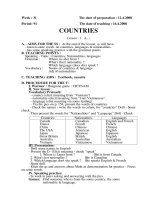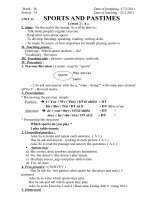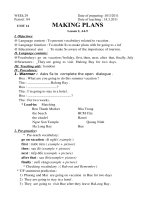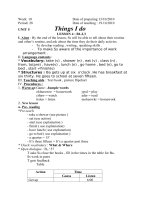giáo án anh văn 6 mới UNIT 4
Bạn đang xem bản rút gọn của tài liệu. Xem và tải ngay bản đầy đủ của tài liệu tại đây (504.09 KB, 12 trang )
UNIT 4 BIG OR SMALL ?
Lesson 1 A1-2 Page 44
Aims: Help Ss reading a description of a school with practice in possessive “s” to talk about possessions
Objectives: By the end of the lesson, Ss will be able to read of a school description & use possessive “s” to talk about possessions.
Teaching aids: poster, wordcards, Text book, posters, word cues.
Proceduces:
Time Contents Teacher’s activities Student’s activities Rationale
5’
15’
15’
WARM UP
Pelmanism
I Thu He You She
His My Your Her Thu’s
PRE-READING
Pre-teach
- big (adj): to, lớn
- small (adj): nhỏ, bé
- in the country: ở nông thôn
- in the city: ở thành phố
Prediction (Matching)
Big Phong’school small
In the country Thu’s school city
WHILE READING A1 (P44)
Comprehension Questions A2 P44
a. Is Phong’s school small?
b. Is Thu’s school small ?
c. Where is Phong’s school ?
d. Is Thu’s school in the country?
+ Answer key:
a. Yes, it is.
-Tick the cards on BB
-Guide how to do
-Use examples and situations to
present new words
-Write this on BB
-Guide
-Read the text
-Guide to answer the questions
-Give the models
-Explain how to use
-Write them on BB
-Guide how to practise
-Write the examples on the board
-Let Ss practise
-Divide into 2 groups
-Each group choose 2 cards.
If the cards have the correct
possessions, Ss win
-Practise in oral
-Listen & Repeat
-Copy down
-Match the information
-Listen
-Read again & answer the
questions individual, pairs
-Listen & Repeat
-Copy down
• help students
remember
grammar
• help students
learn more
new words.
• help students
be able to
analyze
• help students
develop
thinking
abilities
LESSON PLAN – ENGLISH 6 Week: 07 Period: 21
8’
2’
b. No, it isn’t.
c. It is in the country.
d. No, it isn’t.
POST-READING
YES/NO Question Answer Drill
Phong’s school
Thu’s school big/small?
Your school > in the city?
Your house in the country
Nam’house
EX: S1: Is Phong’s school big?
S2: No, it isn’t
S1: Is it in the country?
S2: Yes, it is
HOMEWORK
-Learn vocabulary
-Read A1 again
-Answer the question
-Give examples
+ Yes/no question answer drill
- Run through all word cues
- T models first
- Ss work in groups exchange
- Ss work in pairs : - open pairs-
closed pairs
- Give them some works to do at
home
-Listen
-Practise in pairs –
QuestionsAnswers
-Prepare for the next parts
• help students
be able to
communicate
1 200
2 32
3 45
4 10
5 600
UNIT 4 BIG OR SMALL ?
Lesson 2 A3-5 page 45,46
Aims: Help Ss practise reading a text & get further practise in number and school vocabulary
Objectives: By the end of the lesson, so we will be able to read a text about school to understand details, and use numbers and school vocabulary.
Teaching aids: pictures
Proceduces:
Time Contents Teacher’s activities Student’s activities Rationale
5’
15’
15’
REVISION
Bingo
6, 8, 12, 52, 100,
200, 32, , 400,
17, 25, 600, 900
PRE READING
Open prediction
Phong’s school is in the…(1) It is
(2) There are(3) classrooms. There
are (4)……hundred student in the school.
Thu’s school is in the (5) is (6)
There are (7) rooms. There are
(8) undred students in the school.
WHILE READING
Read the text
Answer Given:
1. in the country
2. small
3. 8
4. 400
5. in the city
6. No, it isn’t. It’s big.
7. 20
8. 900
- Elicit Ss and list the number on BB
- Read: 6 25 200 12
17 400 8 900 20
- Guide to predict
- Model
- Give examples
- Guide Ss to read the text
- Give the answer on BB
- Supply the answer keys after Ss do
- Choose 5 any
numbers from the
board
- Listen and ticks
on their numbers
- Practise in
individual Pairs
- Read again
- Correct their predictions
- Make their own question
- Practise in
individualPairs
- Write down
• help students
remember
vocabulary
• help students
develop
thinking
abilities
• help students
practice with
friends.
• help students
LESSON PLAN – ENGLISH 6 Week: 08 Period: 22
8’
2’
Answer key:
1. Where is Phong’s school?
2. How many classrooms are there in
Phong’s school?
4. How many students are there in Phong’s
school?
3. Where is Thu’s School?
4. Is it small?
5. How many classrooms are there in Thu’s
school?
6. How many students are there in Thu’s
school?
POST READING A4 p.46
Transformation writing
Depending on whether student live in the
city or the country, so take one of the text in
A3 p45 and rewrite it according to their own
school.
HOMEWORK
- Answer the questions A
3,4
in your
notebooks
- Write a short paragraph about your school
- Do Ex
5,6
/P.18-19( exercise notebook)
- Guide student to write a text
- Ask Ss to write a paragraph (4-5
sentences) telling about their school
- Divide the class into 2 groups to
write
- Get Ss writings check
- Give them some works to do at
home
- Write the text on
A3 p.45
- Read the again
- Write the text in groups
-Prepare for the next parts
be able to
analyze
• help students
develop
writing skills
UNIT 4 BIG OR SMALL ?
Lesson 3 B1-5 page 47,48
Aims: Help & practice, listening a dialogue about school to understand details & practicing cardinal numbers, ordinal numbers and “Which”
questions to talk about school.
Objectives: After the lesson, students will be able to listen a dialogue about school, use cardinal and ordinal numbers and “Which” questions to
talk about school.
Teaching aids: poster, cassette, player
Proceduces:
Time Contents Teacher’s activities Student’s activities Rationale
5’
15’
WARM UP
PRE _ LISTENING
Pre-teach B4 P. 48
- floor: ( n) . tầng
- ( to) have: có
- grade: ( n): khối, lớp
Rub out and Remember
-the first = 1
st
-the second = 2
nd
-the third = 3
rd
-the forth = 4
th
-the fifth = 5
th
-the sixth = 6
th
-the seventh = 7
th
-the eighth = 8
th
-the ninth = 9
th
-the tenth = 10
th
Predict dialogue:
- Thu: Hello, Which grade are you in?
- Phong: I’m in grade….(a)…
- Thu : And which class are you in?
-Introduce new words
-Model, write them
- Check voc
- Say the ordinal numbers
- Check spelling
- Give the instruction clearly
- Send students the handouts
- Listen and repeat
- Copy down
- Write the words again
on BB
- Copy down
- Listen
- Read and prepare
• help students
learn more
new words.
• help students
remember
vocabulary
• help students
be able to
analyze
LESSON PLAN – ENGLISH 6 Week: 08 Period: 23
15’
8’
2’
- Phong: (b)… What about you?
-Thu : I’m in grade (c)……, class (d)……
How many floors does your school have?
- Phong :(e)…… It’s a small school.
-Thu : My school has(f)……and… is on
the (g)……floor. Where’s your classroom?
-Phong : It’s on the (h)……floor.
WHILE LISTENING B1 p47
Grid B3 p48
Answer keys.
POST LISTENING
Board Drill
Grade Class Classroom’s
floor
Thu 7 7C 2nd
Phong 6 6A 1st
You 6 6A 3rd
Ex: S1: Which [grade/ class] is Thu in?
S2: She’s in [grade 6/ 6a]
S1: Where’s [her] classroom?
S2: It’s on the [first] floor?
Write – it - up
HOMEWORK
- Learn by heart all ordinal number and
write each word two line.
- Do B5/P.48 in your exercise book.
- Play the tape or read the dialogue
- Draw the charts on the board
- Play the tape the 3
rd
time
- Check listening comprehension
- Give more examples
- Guide Ss to practice
- Guide Ss to write the dialogue again
- Give them some works to do.
- Listen to the tape or the
teacher
- Fill in the blanks
- Listen and correct their
prediction
- Copy down
- Listen and fill the
information in the charts
- Correct their listening
- Listen
- Practise in pairs
- Rewrite the dialogue at
home
- Listen and take notes.
• help students
develop
listening skills
• help students
be able to
communicate
• help students
develop
writing skills
UNIT 4 BIG OR SMALL ?
Lesson 4 C 1 – 2 page 49
Aims: Help Ss practise simple present tense, positive statements with “I” and vocabulary of routines to task about habitual action
Objectives: After the lesson, so we will be able to use simple present, positive statements with “I” and vocabulary of routines to talk about habitual
Teaching aids: word cards, pictures
Proceduces:
Time Contents Teacher’s activities Student’s activities Rationale
5’
15’
WARM UP: Sing an English
song
PRESENTATION
Pre-teach
(to) get up
(to) wash your face
(to) get dresses
(to) have breakfast
(to) brush your teeth
(to) go to school
Slap the board
Presentation Text C1 p. 49
Model sentences.
Mai: What do you do every morning?
Ba: I gets up.
Form:
What do you do every morning?
-Use the pictures on p. 49 to introduce
new words
-Model and write them on BB
-Write these words on BB
- Calls 2 Ss of each group to go to BB
-Say the words in E
-Present the text
-Give the models
-Explain how to use form
- Listen
- Repeat
- Copy down
- Divide into 2 groups
- 2 Ss go to the board
• Help class more
lively.
• help students
learn more new
words.
• help students
remember
vocabulary
• help students
know how to
use new
structure
Mặc quần áo
Ăn
sáng
Đánh răng
Rửa mặt
Đi học
Thức dậy
LESSON PLAN – ENGLISH 6 Week: 08 Period: 24
15’
8’
2’
I + V( bare-inf)
- > Use: To talk and answer about
habitual action
PRACTICE
Word Cue Drill
Ex: S1: What do you every morning?
S2: I get up
S1: What do you do [then] ?
S2: etc.
FURTHER PRACTICE
Chain Game
S1: I get up
S2: I get up and I brush my teeth
S3: I get up, I brush my teeth and I get
dressed
S4: ect…
HOMEWORK:
- Learn Voc, structures
- Write the things you do every morning
- Do C1- p.43
- Give the instructions clearly
- Write these words on BB
- Give examples
- Guide the game
-Give example exchange and write it on
BB
- Write homework on BB
- Slap the word in Vnese.
- Copy down
- Practise in pairs
- Pay attention
- Complete the phrases
- Practise base on the
example exchange
- Practise in pairs
- Practise in groups
- Listen and take notes
• help students
practice with
new structure
• help students
remember the
words and use
them
….up
….dressed ….teeth
….face
….school
….breakfast
UNIT 4 BIG OR SMALL ?
Lesson 5 C 1 – 3 page 49
Aims: Help & practice simple present tenses, positive statements with He/ She to talk about habitual action
Objectives: By the end of the lesson,students will be able to use simple present tenses, positive statements with He/ She to talk about habitual
Teaching aids: poster, wordcards, Text book, posters, word cues.
Proceduces:
Time Contents Teacher’s activities Student’s activities Rationale
5’
15’
15’
REVISION
Making
(to) get up
(to) get dressed
(to) brush your teeth
(to) wash your face
(to) have breakfast
(to) go to school
(to) say hello to classmate
(to) go to the classroom
PRESENTATION
Presentation Text C1 p.49
Model Sentences
- What does Ba/ he/ she do every
morning?
- Ba gets up
- He brushes his/ her teeth
has breakfast
-She goes to school
-Draw the picturesand write these words
on BB
-Let st match the pictures with the words
in correct meanings
- Present the text
- Guide Ss to read
- Give the models sentences
- Explain :Form, use, meaning
- See the pictures
- Read the words
- Match the words with
the pictures
- Practise in writing
- Listen
- Repeat
- Copy down
- Practise in pairs
• help students
remember
vocabulary
• help students
develop reading
skills
• help students
know how to
use new
structure
• help students
Hello
THCS
p.tắm
LESSON PLAN – ENGLISH 6 Week: 09 Period: 25
8’
2’
PRACTICE
Word cue Drill
S1: I get up
S2: I get up and I brush my teeth
S3: I get up, I brush my teeth and I get
dressed
S4: ect…
PRODUCTION
Write- it- up
a) C3 p.49
b) Write 5 sentences about what you do
every
morning. Begin with: “Every
morning…”
HOMEWORK
- Learn the new words.
- Practice with the new structures.
- Tick the wordcards on BB
- Give example exchange
- Model
- Write it on BB
- Guide Ss to write
- Give them some works to do at home
- Complete the Phrases
- Say them loudly
- Base on the example to
practice in pairs, groups.
- Write the sentences to
begin with “Every
morning I get up. Then I
…”
- Listen and take notes.
practice with a
new structure
• help students
develop writing
skills
….up
….dressed
….teeth
….face
….school ….breakfast
UNIT 4 BIG OR SMALL ?
Lesson 6 C4-7 page 50, 51
Aims: Help students practice talking the time.
Objectives: After the lesson, students will be able to tell the time
Teaching aids: pictures, word cards, real things.
Proceduces:
Time Contents Teacher’s activities Student’s activities Rationale
5’
15’
WARM UP
Number dictation:
PRESENTATION
Pre-teach
- The time: thời gian
- ( ten) o’clock: (7) giờ sáng
- half past(ten): (10) giờ rưỡi
- to be late for: muộn
What and Where
Presentation Pictures C4 – p. 50
Model Sentences
Lan: What time is it, Ba?
Ba: It’s is eight o’clock
half past eight.
Form:
What time is it/ What is the time?
It is + Số giờ +o’clock ( giờ đúng)
Số giờ+ phút ( giờ hơn)
T. read: one ten, five twenty, three
fifteen, six forty, seven thirty, ten thirty,
twelve twenty five.
- Pre teach , Vocab
- Elicit the word from the Ss
- Ss read the Vocab chorally then
individually
- Checking the Vocab
- What and Where
- Present the pictures to gives the model
sentences
- Explain
Ss write: 1.10, 5.20 ,
3.15, 6.40, 7.30, 10.30,
12.25.
- Write:1.10, 4.30 ect
- Practise saying these
numbers with a partner
- Listen –repeat
- Copy down
- Read many time
- Repeat
- Rewrite the words
- Pay attention
- Practise in pairs
- Copy down
Haft past ten
Late
10 o’
clock
8 o’clock
The time
LESSON PLAN – ENGLISH 6 Week: 09 Period: 26
15’
8’
2’
PRACTICE
Picture/ Realia Drill
6:00 2:10 1:00 5:15
1:30 9:45 8:25 7:30
Ex: - What time is it?
- It’s [two ten]
Word Cue Drill C7- p51
Ex: - What time do you get up?
- at [six o’clock]
FURTHER PRACTICE
Noughts and Crosses
Ex: - What’s the time?
- It’s [six ten]
6.10 6.30 6.45
7.00 11.00 11.30
3.15 4.20 5.30
HOMEWORK
- Study the vocabulary.
- Do the exercises
- Make 5 sentence telling the time
- Use pictures to practise
- Give example
- Write it on BB
- Show some words cues on the board
-Ask Ss to practise
-Draw the charts on BB
- Guide to do
- Give them some works to do at home
- See the pictures
- Practise orally and
individually
- Copy
- See word cues
- Practise in pairs
- Divide into 2 groups
- Practise in teams
- Listen and take notes
Have breakfast
Go home
Get up
Go to school
TỔ TRƯỞNG CHUYÊN MÔN









